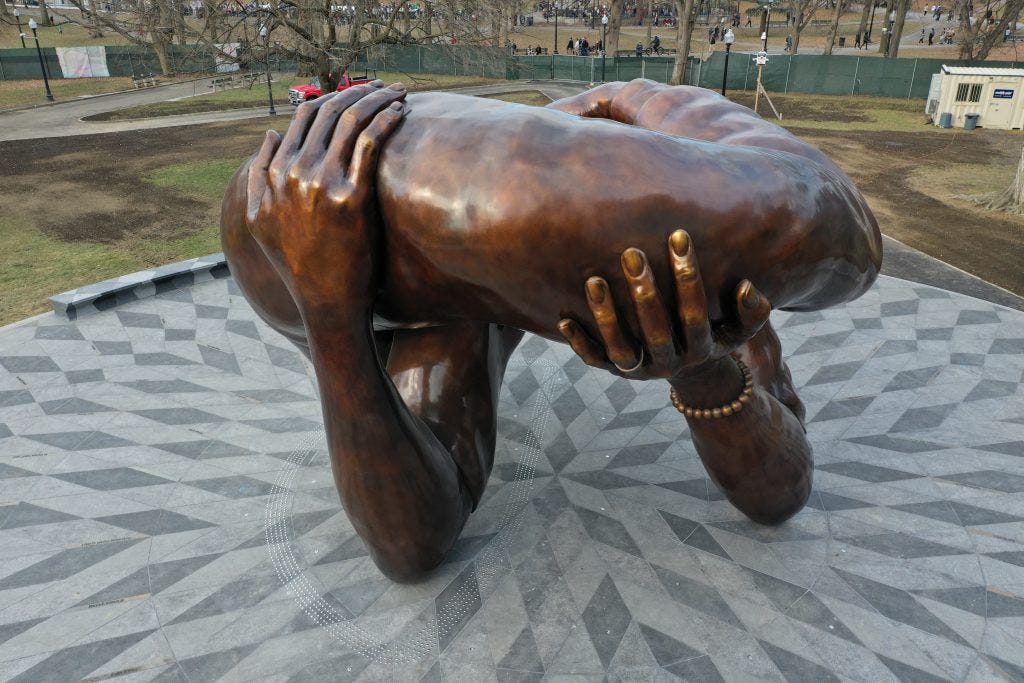Boston last week unveiled its latest public art installation, a sculpture meant to honor Martin Luther King Jr. and his wife Coretta, said sculpture pictured above. King was one of the greatest Americans who ever lived and Coretta was his long-suffering wife who for years put up with his admittedly disgraceful dalliances, so you’d think the city would figure out some way to commemorate the two that would look better than this genuine monstrosity. From some angles it looks like a butt, from others it looks like a gigantic penis, and from the remaining angles it looks like a tangled mess of bronze and nothingness. It’s reprehensible, a public disgrace, the sort of thing over which dozens of people should be fired.
It is okay to hate this kind of thing. Truly it is. This kind of “art” legitimately makes your life worse and you should absolutely be disgusted by and opposed to it. Do you know why it makes your life worse? Because it’s really, really ugly. Looking at really ugly stuff is unpleasant and it makes you unhappy and angry. That’s not good. This isn’t rocket science. Don’t overthink it.
If you want an example of a good monument to a great civil rights leader, here’s one of Fredrick Douglass at a Maryland county courthouse:
Is this the greatest statue ever made? No. But it is fine and it more than gets the job done. It is recognizably human, it captures the subject in an intense and compelling activity for which he was well known, it might even actually stir somebody to some form of historical reflection or civic pride or patriotism or even just an emotive swelling of the chest. The ridiculous, clownish Boston statue doesn’t even portend to do any of these things; instead it seeks to bamboozle you with meaningless form and empty meaning.
There’s a reflexive impulse in modern life to assume that this kind of simple assessment and criticism is beyond the reach of the average citizen, and that to truly understand and criticize this kind of art you must have a high level of education, technical knowledge, artistic comprehension and overall refinement. This is false. There is no secret here, absolutely no hidden methods or higher couth you need in order to recognize that an ass-like, dong-like sculpture of a pair of headless formless arms is really bad and ugly and unappealing. You can see it plainly, acknowledge it, accept it. Congratulations: You’re an art critic, and you’re better at the job than whoever made this statue.
Many people will respond to this type of argument with a common kind of retort: “Well some people will like this statue. Art is all subjective so there’s really no ‘good’ and ‘bad’, it’s all according to taste.” You know who actually believes this? Nobody. Everyone has some sort of art they think is objectively bad—some sort of musical genre or specific artist, a certain film or a style of filmography, a hated writer or a hated category of fiction. When given the chance they will describe their hatred of this artistic form with great élan, using adjectives and modifiers you never thought possible, holding court for hours if you let them.
This is normal and good. It’s okay to try and passionately convince people of certain things—such as, for instance, that the new MLK statue is an ugly thing, that it looks like mushed-up genitalia, and that is a truly terrible tribute to a great man and is a blight upon the city in which it has been installed.
Don’t be pressured into believing that you’re not allowed to critique art. If you hate a piece of art, say why. Better yet, if it’s a public work of art, tell your local politicians and elected leaders why you hate it, and why it should be torn down. That kind of backlash to bad art can and does get results. But before that, you have to permit yourself to really hate this sort of thing. And you should. Don’t be shy. Don’t back away from despising this kind of art. Call it by its name.




